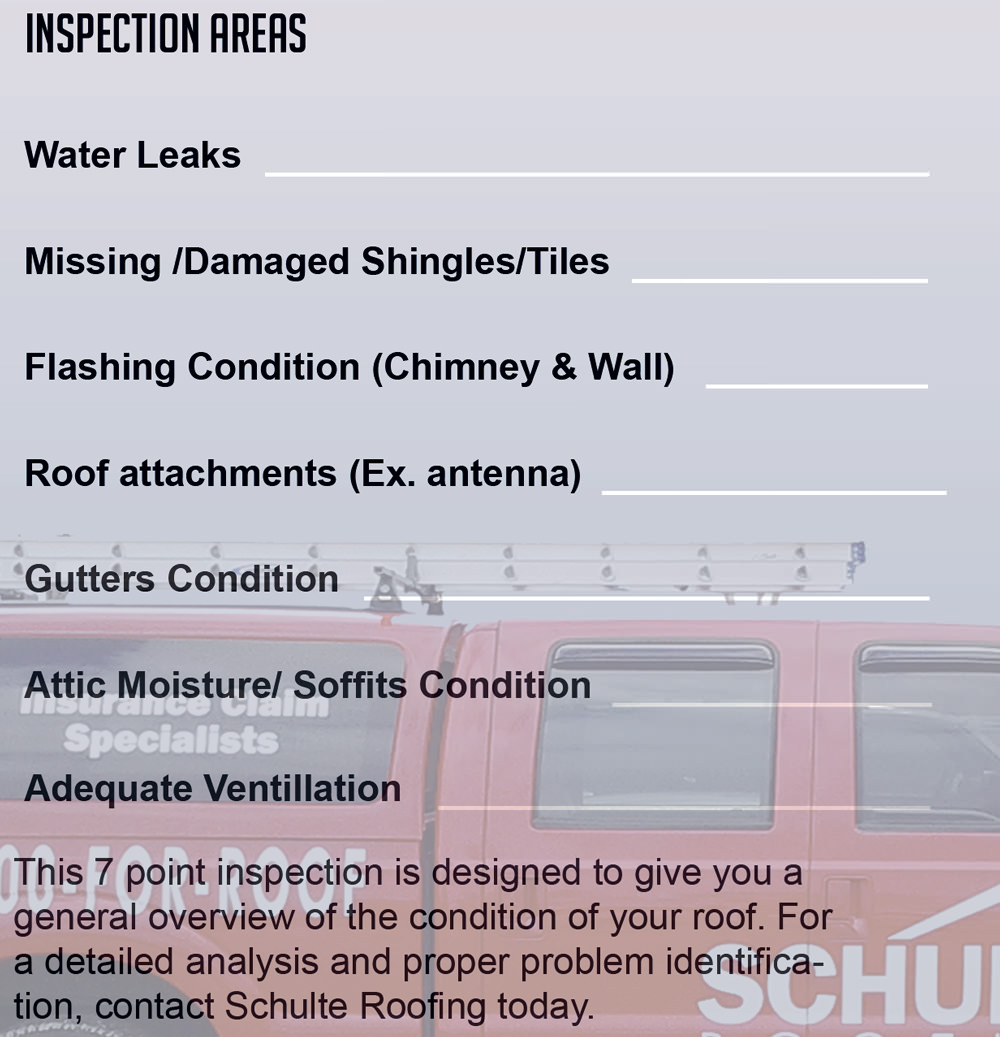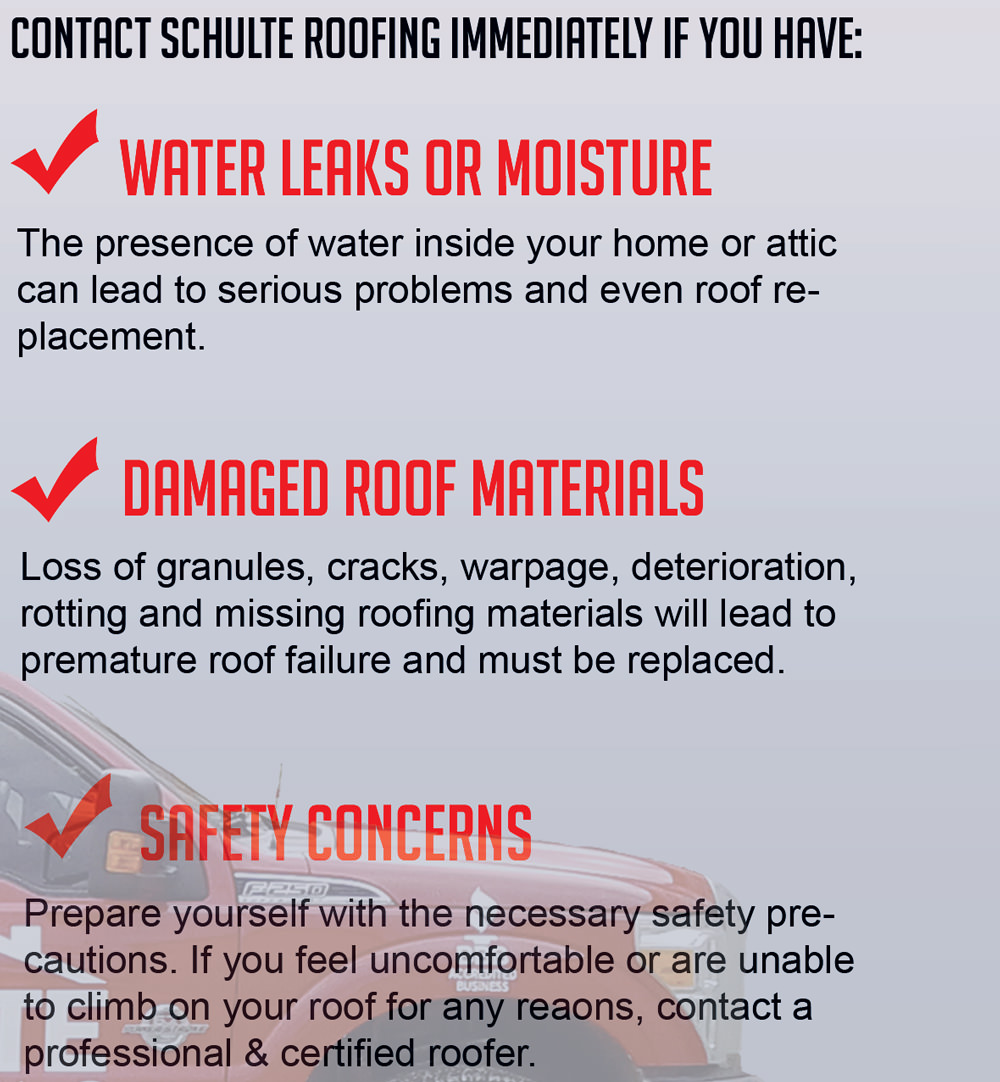The 7 Point Roof Inspection Checklist is a quick way for homeowners to review the condition of their roof at a moment’s notice. The checklist can be used as a quick reference guide for spring cleanups, weekend warrior projects, and fast inspection after storms. Below is a brief explanation of the roof inspection template, explaining each area of the roof and the download forms of the checklist.
Water Leaks
Water leaks of any kind are a big problem and should be addressed immediately. There are common areas where leaks are known to occur like areas near windows, chimneys, and vents. Water leaks can also be hidden near corners or behind dry wall. It is important to properly identify the cause of the water leak so you can make the proper repair.
Water leaks are often slow forming with the homeowner only noticing after significant damage has already been done. The presence of even a little water can be a sign of a bigger leak behind any wet spot that might be found. Be sure to thoroughly inspect the area.
Missing or Damaged Shingles and Tiles
Shingles and tiles are the outer layer of protection for the entire roofing system. Without them in place weathering elements from the sun, rain, temperature, and wind will wear and age the roofing system in the exposed area and underlayment exponentially faster. Roofs without adequate underlayment and roofing components are almost always guaranteed to leak, resulting in greater damage than that of an ordinary leak.
Besides a shoddy appearance, missing roofing components also cost homeowners more in energy costs. Roofing shingles and tiles are now specially designed to help keep cooling costs down in the summer and heating costs down in the winter. In each area where roofing components are missing, the energy efficiency of the roofing system is dramatically reduced. Additionally, surrounding and nearby shingles and tiles will wear exponentially faster as well.
Flashing Condition
Flashing is an extremely important part of roofing. It is directly responsible for channeling water and other debris away from important openings in the roofing system. It is often used to help seal any openings like the roof edge or around chimneys.
If the flashing is aged or worn it may curl or loosen form allowing water and other debris to enter the space between the flashing and the home. This condition allows water to directly enter the roofing system and the home.
Roof Attachments
Many homeowners enjoy satellite dishes, cell phone repeaters, and solar systems. These attachments must be installed correctly to prevent leaks. And no, caulking is not enough. Inspect any roof attachments for signs of corrosion or rust.
Typically the attachment areas are small in size, but are responsible for almost all slow forming leaks in the middle of the roof. In many cases water will enter through the attachment’s piercing into the roof. It will then slowly corrode each layer of roofing material until you see a small wet spot form on your ceiling. Ignoring this issue often results in having to use pots and pans the next time it rains.
Condition of the Gutters
Gutters are primarily designed for one reason; to move water away from your home. Clogged gutters should be cleaned thoroughly to avoid any potential back-flow and water build-up. Additionally, they should be firmly attached to the house, with the roof edge overlapping the gutter. The distance of overlap is dictated by building code, weather conditions, and roofer expertise. Without properly functioning gutters, water will collect around the home, corroding important structural elements.
Perhaps one the biggest reason to maintain properly working gutters is to prevent issues with the home’s foundation. Water that continually builds near the home’s foundation will cause settling and movement in the surrounding soil. This settling results in visible cracks in the foundation, cracks in exterior and interior walls, and space between the chimney and the home.
Attic, Soffit, & Adequate Ventilation
Any moisture found in the attic is important to identify because it may signify a direct issue with the roofing system. Some homes have water heaters in the attic which may send a false signal about the roof’s condition. Be sure to identify the source of the leak properly.
The soffit is the area of the roof overhang (the area between to exterior wall and roof edge). The soffit serves to move and circulate air from the inside of the home to the outside and vice versa. In addition to being a leak, moisture found in these areas means that warm air and cool air are mixing allowing moisture to build up.
Moisture in this area could also be due to faulty workmanship. The soffit should be located a specific distance away from the exterior wall and siding. This distance is determined by building code, weather, and roofing expertise. If the soffit is located too close to the exterior wall, moisture is almost guaranteed to accumulate. If the soffit is too far from the exterior wall, then there is not enough airflow, increasing cooling costs and reducing efficiency. 90% of all roof repairs involved workmanship issues and are not related to possible warranty coverage or faulty materials.
When You Need a Professional
Safety and security is a principle concern so be sure to take the necessary safety precautions when inspecting your roof. If you find a leak in any of these areas, find missing materials, have safety concerns or just general questions, contact Schulte Roofing. Ask about the Overhead Care Club™ which offers reduced repair fees, annual 17 point inspections, priority emergency service, and free cleanings.
View the full form or download the PDF.


